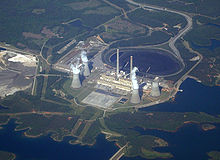If the Southern Company’s slick nuclear financing deal and its ongoing operation of three of the country’s dirtiest coal plants (two of them in Georgia) is such a good deal, why are so many insiders selling so much stock?
Maybe SO CEO Thomas A. Fanning needed that $12.4 million he got back in January by selling 275,617 shares at $45.0693 per share for a new yacht,  or a new wing on his house, or something. A brief scan of nearby energy companies (Duke and Progress) indicates it’s not unusual for an energy company CEO to sell shares, although mostly not for this much dollar amount. $12.4 million is more than twice Fanning’s 2010 salary of $6.02 million, and well more than his 62% raised 2011 salary of $9.75 million that Georgia Power customers get to help pay for through Construction Work in Progress (CWIP) charges for the new nukes at Plant Vogtle that won’t be built for years, if ever.
or a new wing on his house, or something. A brief scan of nearby energy companies (Duke and Progress) indicates it’s not unusual for an energy company CEO to sell shares, although mostly not for this much dollar amount. $12.4 million is more than twice Fanning’s 2010 salary of $6.02 million, and well more than his 62% raised 2011 salary of $9.75 million that Georgia Power customers get to help pay for through Construction Work in Progress (CWIP) charges for the new nukes at Plant Vogtle that won’t be built for years, if ever.
 But what’s with two SO subsidiary company CEOs, Mark A. Crosswhite, President and CEO of Gulf Power ( #206 on the Forbes Global 2000 in 2010) and Edward Day VI, President and CEO of Mississippi Power Company ( former engineering group supervisor at the Hatch Nuclear Project)
But what’s with two SO subsidiary company CEOs, Mark A. Crosswhite, President and CEO of Gulf Power ( #206 on the Forbes Global 2000 in 2010) and Edward Day VI, President and CEO of Mississippi Power Company ( former engineering group supervisor at the Hatch Nuclear Project)  selling a bunch of stock in April? Also there have been only a couple of puny little purchases, each of less than $30,000, in the past year. Why so much selling and so little buying by insiders?
selling a bunch of stock in April? Also there have been only a couple of puny little purchases, each of less than $30,000, in the past year. Why so much selling and so little buying by insiders?
 Maybe new nukes are an increasingly bad business risk for Southern Company and Georgia Power. Perhaps some economic expert can help with this question;
how about
Moody’s?
Maybe
Georgia Power customers and Georgia and U.S. taxpayers and voters have an opinion?
Maybe new nukes are an increasingly bad business risk for Southern Company and Georgia Power. Perhaps some economic expert can help with this question;
how about
Moody’s?
Maybe
Georgia Power customers and Georgia and U.S. taxpayers and voters have an opinion?
I wonder what will happen to SO’s insider trading patterns when SO’s illusion of certainty of profit from nuclear and coal  eventually becomes obvious even to their board and shareholders as actually a big risk, and when SO realizes Cobb EMC made the right choice for profit by ditching coal plant plans and building solar plants instead; when SO finally suddenly switches to solar like Cobb EMC and Austin Energy already did. Will insiders decide SO’s stock has become a good buy when SO builds solar and wind plants?
eventually becomes obvious even to their board and shareholders as actually a big risk, and when SO realizes Cobb EMC made the right choice for profit by ditching coal plant plans and building solar plants instead; when SO finally suddenly switches to solar like Cobb EMC and Austin Energy already did. Will insiders decide SO’s stock has become a good buy when SO builds solar and wind plants?
-jsq










